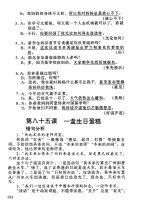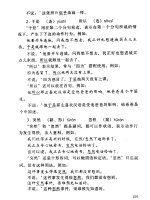2.7 Tyrannosaurus rex (earth science)
Bạn đang xem bản rút gọn của tài liệu. Xem và tải ngay bản đầy đủ của tài liệu tại đây (2.65 MB, 10 trang )
Genre
Nonfiction
Comprehension Skill
Retell
Text Features
• Captions
• Labels
• Glossary
Science Content
Fossils and
Dinosaurs
Scott Foresman Science 2.7
ISBN 0-328-13789-8
ì<(sk$m)=bdhijd< +^-Ä-U-Ä-U
Vocabulary
Extended Vocabulary
dinosaur
fossil
extinct
paleontologist
anatomy
computer animation
models
continents
Cretaceous period
dung
excavate
scavenger
What did you learn?
1. What is the Cretaceous period?
2. Why did T. rex have a lot of holes
in its skull?
3.
changed their ideas about how
T. rex moved. Write to explain
what scientists used to think and
what they think now. What made
them change their minds?
4.
Picture Credits
Every effort has been made to secure permission and provide appropriate credit for photographic material.
The publisher deeply regrets any omission and pledges to correct errors called to its attention in subsequent editions.
Photo locators denoted as follows: Top (T), Center (C), Bottom (B), Left (L), Right (R), Background (Bkgd).
6 (BL) Bettmann/Corbis; 7 (B) Bettmann/Corbis.
Scott Foresman/Dorling Kindersley would also like to thank: 5 (BL) Stephen Oliver/DK Images.
Unless otherwise acknowledged, all photographs are the copyright © of Dorling Kindersley, a division of Pearson.
ISBN: 0-328-13789-8
Copyright © Pearson Education, Inc. All Rights Reserved. Printed in the United States of America.
This publication is protected by Copyright, and permission should be obtained from the publisher prior to any
prohibited reproduction, storage in a retrieval system, or transmission in any form by any means, electronic,
mechanical, photocopying, recording, or likewise. For information regarding permission(s), write to
Permissions Department, Scott Foresman, 1900 East Lake Avenue, Glenview, Illinois 60025.
3 4 5 6 7 8 9 10 V010 13 12 11 10 09 08 07 06 05
by Susan Jones
Leeming
Scientists
Retell Some scientists think
that T. rex was a hunter and some
think he was a scavenger. In your
own words tell what clues we
have about how T. rex got its
food. Use the information on
pages 12–13 to help you.
What You
lready Know
What
YouAAlready
Know
Fossils are the remains of plants or animals
that lived long ago. A fossil can look like an
animal footprint or a print of a leaf. Some
animal fossils come from old bones or other
animal parts. They were made after an animal
died and got covered by layers of mud. Over
thousands of years the mud turned to stone.
The shape of the animal got left in the stone.
Paleontologists study fossils to find out about
animals that are extinct, or that are no longer
living on Earth. Dinosaurs are extinct animals.
Paleontologists study their fossil remains to learn
about them. Through studying
fossils, paleontologists get
ideas about how dinosaurs
looked and what they ate.
Paleontologists learn new things when they
find new fossils. Not too long ago they made a
new discovery about a dinosaur called Oviraptor.
Paleontologists thought they had found a fossil
of an Oviraptor stealing and eating eggs. Now
they know the eggs were the Oviraptors’ own.
In this book, you will
read about some other
dinosaur discoveries.
You will learn what
paleontologists have
discovered about
a dinosaur called
Tyrannosaurus rex.
Tyrannosaurus rex
ammonite fossil
2
3
Who was T. rex?
Tyrannosaurus rex, or T. rex for short, is one
of the most famous dinosaurs to walk the Earth.
Tyrannosaurus rex is a Latin name. It means
“tyrant king lizard.”
T. rex is one of the largest meat-eating
animals ever to have lived. It could grow as
long as a large fire truck and as heavy as three
cars. T. rex was tall enough to see over the top
of an elephant!
During the Cretaceous period
Earth looked very different than
it looks today.
This giant lived at the end of the
Cretaceous (kri-TAY-shuhs) period. This is what
scientists call the time when dinosaurs such as
T. rex lived. The Cretaceous period was the time
between 135 million and 70 million years ago.
Scientists believe that Earth
changed a lot during the
Cretaceous period. The
Earth’s continents moved and
changed shape. At the end of
the Cretaceous period,
dinosaurs became extinct.
T. rex was one of the biggest
meat-eating dinosaurs of the
Cretaceous period.
4
5
Discovery!
T. rex became extinct at the
end of the Cretaceous period, but
some T. rex bodies got buried under
sand and mud. Their skeletons slowly
turned into fossils.
Barnum Brown was one of the first
scientists to study dinosaurs. In 1902 he
found some fossils in Montana, U.S.A. It was
hard to excavate the fossils, as they were buried
in rock. The fossils turned out to be the bones of
a T. rex skeleton!
After the scientists dug out the fossil bones,
they moved them to a museum in New York.
Scientists at the museum
studied the fossils. They
rebuilt the T. rex skeleton.
T. rex skeleton
Scientists have found T. rex bones
in other parts of North America.
These discoveries have given us clues
about where T. rex lived. The bones
have also given scientists a way
to study T. rex’s anatomy. An animal’s anatomy
is how its body looks and works.
excavation of T. rex at Hell Creek, Montana
Barnum Brown, a scientist,
discovered T. rex fossils in 1902.
6
7
T. rex Anatomy
If you look at the anatomy of T. rex, you will
see that its feet looked a little like bird feet. Each
foot had three toes with claws.
T. rex’s long, scaly back legs had very strong
muscles. T. rex needed these muscles to support
its heavy body. T. rex’s forelegs were much
smaller! They didn’t even reach its mouth.
Scientists think T. rex used its
small forelegs for balance. T. rex
may have used them to get up
off the ground after lying down.
For some time scientists believed T. rex moved
upright like a penguin. They thought its thick,
heavy tail hung straight down, almost touching
the ground. Now, scientists have computer
animation models of T. rex. Scientists use these
models to get new ideas about how T. rex might
have moved.
Scientists now think that T. rex must have
moved with its chest closer to the ground. It may
have lifted its tail off the ground to help balance
its heavy body.
T. rex’s feet had
three bird-like toes.
T. rex probably ran with its
chest to the ground, using
its tail for balance.
8
9
Perhaps T. rex had
holes in its skull to
make it lighter.
T. rex had a very heavy skull. Fossil
T. rex skulls have large and small holes. Some of
these holes were for its eyes and ears. Scientists
think that some of the holes were empty space to
make the skull lighter.
When you see how large T. rex was, its brain
seems tiny! But T. rex’s brain was bigger than
those of many plant-eating dinosaurs. This may
be because T. rex needed to do more thinking.
Instead of just eating plants, it needed to think
about how to hunt and catch its prey.
T. rex had very powerful jaws. A T. rex
could have swallowed a human being whole!
Its teeth had saw-like edges. These teeth left
marks in the bones of the animals it ate.
Scientists can use these bones to figure out
what T. rex ate.
Each T. rex tooth was at least seven inches
long. This is about as long
as your forearm! With
jaws and teeth like that,
T. rex could easily eat
other animals.
fossil of a T. rex tooth
T. rex had powerful jaws
filled with saw-like teeth.
10
11
Hunter or scavenger?
A hunter is an animal that eats other animals
it catches. A scavenger is an animal that eats
the leftover parts of animals caught by others.
Many scientists think T. rex was mostly a
hunter. They think that T. rex used its strong
back legs to chase other animals. They think it
killed its prey with its powerful jaws. Animals
that hunt need to have good eyes. Some
scientists think that T. rex could see very well.
T. rex used its powerful
jaws to eat its kill. But
did it hunt for its food
or scavenge?
12
Other scientists think that T. rex was
a scavenger. They think its eyes were too
small to see well. They think T. rex was too
heavy to run fast. These scientists also think
that T. rex used a large part of its brain for
smelling. Scavengers need to be able to smell
dead animals from very far away.
In truth, T. rex was probably both a hunter
and a scavenger. It used its eyes and powerful
jaws to hunt and kill smaller animals. It may
also have used its sense of smell to find dead
dinosaurs to scavenge.
13
Although scientists may not agree on how
T. rex ate, they do agree on what it ate. Fossils
of dinosaur dung show that T. rex ate mostly
smaller, plant-eating dinosaurs. It also may have
eaten a large dinosaur called Triceratops.
Triceratops was a plant eater, but it had sharp
horns and thick skin. Triceratops must have
been hard to catch and eat, even for T. rex
with its powerful jaws!
Dinosaur Mysteries
T. rex is one of the most interesting and
amazing animals that ever lived. Paleontologists
still want to know more about this “king of
lizards.” Perhaps scientists will discover new
fossils that will help us learn more. Perhaps
they will find new ways to study fossils. Maybe
we will find out for sure if T. rex was a hunter
or a scavenger. Until then, many people will
ask questions about this mysterious giant.
What questions do you have?
T. rex probably ate slowmoving duck-billed dinosaurs.
14
15
Vocabulary
Glossary
dinosaur
Extended Vocabulary
anatomy
computer animation
fossil
models
extinct
anatomy
how
an animal’s body
continents
paleontologist
looks and moves
Cretaceous period
computer animation dung
computer images of
excavate
models
how animals move
scavenger
continents
seven great areas of
land on Earth
Cretaceous period
the time when T. rex
lived
dung
animal waste
Picture Credits
Every effort has been made to secure permission and provide appropriate credit for photographic material.
The publisher deeply regrets any omission and pledges to correct errors called to its attention in subsequent editions.
excavate
to dig up and remove
from the ground
Photo locators denoted as follows: Top (T), Center (C), Bottom (B), Left (L), Right (R), Background (Bkgd).
6 (BL) Bettmann/Corbis; 7 (B) Bettmann/Corbis.
Scott Foresman/Dorling Kindersley would also like to thank: 5 (BL) Stephen Oliver/DK Images.
Unless otherwise acknowledged, all photographs are the copyright © of Dorling Kindersley, a division of Pearson.
scavenger
ISBN: 0-328-13789-8
an animal that finds
and eats leftover parts
of dead animals
Copyright © Pearson Education, Inc. All Rights Reserved. Printed in the United States of America.
This publication is protected by Copyright, and permission should be obtained from the publisher prior to any
prohibited reproduction, storage in a retrieval system, or transmission in any form by any means, electronic,
mechanical, photocopying, recording, or likewise. For information regarding permission(s), write to
Permissions Department, Scott Foresman, 1900 East Lake Avenue, Glenview, Illinois 60025.
16
3 4 5 6 7 8 9 10 V010 13 12 11 10 09 08 07 06 05
What did you learn?
1. What is the Cretaceous period?
2. Why did T. rex have a lot of holes
in its skull?
3.
Scientists
changed their ideas about how
T. rex moved. Write to explain
what scientists used to think and
what they think now. What made
them change their minds?
4.
Retell Some scientists think
that T. rex was a hunter and some
think he was a scavenger. In your
own words tell what clues we
have about how T. rex got its
food. Use the information on
pages 12–13 to help you.









